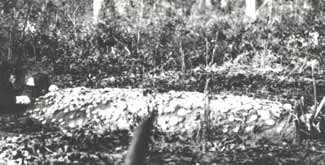South Carolina – African-Americans – Slave Burials
Also see: African-Americans - 1525-1865 Main Page
Written by Michael Trinkley of the Chicora Foundation
By the Light of Torch
In spite of the fact that disease and death were so common on lowcountry plantations, there are very few accounts of slave burials. Thomas Chaplin, a cotton planter on St Helena Island in Beaufort County, kept a detailed diary of his plantation activities. Yet he mentions the making or purchasing of coffins for black slaves on only two occasions. He describes only one African-American burial, on May 6, 1850:Got Uncle Ben's [slave] Paul to make coffin for poor old Anthony. The body begins to smell very bad already, had it put in the coffin as soon as it came. Buried the body alongside of his son about 11 o'clock at night .... There were a large number of Negroes from all directions present, I suppose over two hundred.Another slave burial, on Georgia's Butler Island, was described by Frances Anne Kemble in early 1839:
Yesterday evening the burial of the poor man Shadrack took place .... just as the twilight was thickening into darkness I went with Mr. [Butler] to the cottage of one of the slaves ... who was to perform the burial service. The coffin was laid on trestles in front of the cooper's cottage, and a large assemblage of the people had gathered round, many of the men carrying pine-wood torches .... the coffin being taken up, proceeded to the people's burial ground. ... When the coffin was lowered the grave was found to be partially filled with water – naturally enough, for the whole island is a mere swamp, off which the Altamaha is only kept from sweeping by the high dikes all round it. This seemed to shock and distress the people ....Of the hundreds of eighteenth and nineteenth century maps and plats, only a small handful show the location of slave cemeteries – mute testimony to how insignificant these plots of land were to the slaves' masters. These two examples show the "graveyard" or "burial grounds" in marginal locations – next to water or in low, swampy areas not fit for agriculture. They are also poorly defined on the maps and lack any roads directly to them.
Sam Polite, a freed slave, explained why so many burials took place at night: "When nigger dead, you can't knockoff work for bury'um. You have to wait till nighttime to put'um in the grave. You bury 'um by the light of torch."

African-American Grave Covered with Shells
Springfield, South Carolina, 1931
© Brookgreen Gardens
Another ex-slave, Elijah Green, repeated this observation: "Slaves was always buried in the night, as no one could stop to do it in the day. Old boards was used to make the coffin that was blackened with shoe polish."
While owners seem to have had little interest in the burials of their slaves, the African Americans seem to have had even less interest in having whites present during this most solemn event. Burial provided an opportunity to provide dignity that was denied during life and African American beliefs held that the dead would be returning to Africa – and to a far better life.
Charleston Hotels
Columbia Hotels
Greenville Hotels
Myrtle Beach Hotels
Charleston Real Estate
Columbia Real Estate
Greenville Real Estate
Myrtle Beach Real Estate
Charleston Jobs
Columbia Jobs
Greenville Jobs
Myrtle Beach Jobs
SC Arts & Entertainment
SC Businesses
SC Calendar of Events
SC Churches
SC Cities, Towns
SC Colleges, Universities
SC Consumer Help Desk
SC Counties
SC Education
SC Elections
SC Facts & Firsts
SC Genealogy
SC Gifts
SC Government, Politics
SC Health, Medicine
SC History
SC Hotels
SC Jobs
SC Libraries, Museums
SC Maps
SC Movies
SC News
SC Organizations
SC Photo Gallery
SC Plantations
SC Pronunciations
SC Real Estate
SC Restaurants
SC Schools
SC Sports, Recreation
SC Tax Guide
SC Tides
SC Tourism
SC Vacation Rentals
SC Web Cams
SC Weddings
SCIWAY . . . "sky-way" . . . South Carolina Information Highway© 2024 SCIWAY.net, LLC All rights reserved. |




